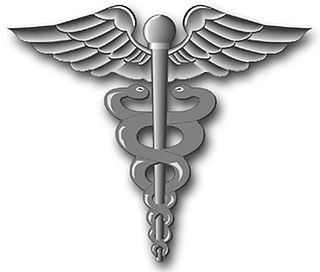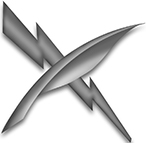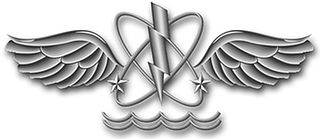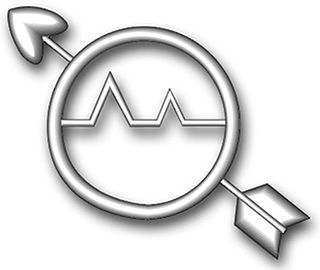Related Research Articles

Command master chief petty officer (CMDCM) is an enlisted rating in the United States Navy and U.S. Coast Guard, as well as the Japan Maritime Self-Defense Force.

The surface warfare insignia is a military badge of the United States Navy which is issued to U.S. Navy personnel who are trained and qualified to perform duties aboard United States surface warships. There are presently four classes of the surface warfare pin, being that of line, staff, special operations, and enlisted. The line and enlisted surface warfare badges may be earned by United States Coast Guard personnel assigned to Navy commands. The various badge types are as follows:
The Enlisted Aviation Warfare Specialist (EAWS) insignia is a military badge of the United States Navy which was created in March 1980. The insignia recognizes those members of the Navy's enlisted force who have acquired the specific professional skills, knowledge, and military experience that result in qualification for service in the aviation activities of the Navy. This includes most personnel who are trained flight deck personnel onboard aircraft carriers, or maintenance personnel at an Aircraft Intermediate Maintenance Detachment or Department (AIMD) or aircraft squadron.

Insignias and badges of the United States Navy are military badges issued by the United States Department of the Navy to naval service members who achieve certain qualifications and accomplishments while serving on both active and reserve duty in the United States Navy. Most naval aviation insignia are also permitted for wear on uniforms of the United States Marine Corps.

A hospital corpsman is an enlisted medical specialist of the United States Navy, who may also serve in a U.S. Marine Corps unit. The corresponding rating within the United States Coast Guard is health services technician (HS).

Cryptologic Technician (CT) is a United States Navy enlisted rating or job specialty. The CT community performs a wide range of tasks in support of the national intelligence-gathering effort, with an emphasis on cryptology and signal intelligence related products.

Storekeeper (SK) is an enlisted rating in the United States Coast Guard; until 2009 it was also a United States Navy rating, the most common supply rate in U.S. Navy vs. CS and SH and very much equivalent to the MOS 92 of the U.S. Army. In the Navy this rating, together with PC, has been renamed or superseded by the rating logistics specialist (LS).
The Navy Enlisted Classification (NEC) system supplements the rating designators for enlisted members of the United States Navy. A naval rating and NEC designator are similar to the Military Occupational Specialty (MOS) designators used in the U.S. Army and U.S. Marine Corps and the Air Force Specialty Code (AFSC) used in the U.S. Air Force.

Radioman (RM) was a rating for United States Navy and United States Coast Guard enlisted personnel, specializing in communications technology.

Robert James Walker, Sr. was a senior sailor in the United States Navy who served as the third Master Chief Petty Officer of the Navy. He was born in Baldwin, New York, and attended grammar and high school in Oxford, New York.

Aviation electronics technician (AT) is a US Navy enlisted rating or job specialty. At the paygrade of E-9, ATs merge with the aviation electrician's mate (AE) rating to become avionics technicians (AV). There has been talk of completely merging the two ratings, but as yet no definite plans have been announced. Aviation electronics technicians wear the specialty mark of a winged helium atom.

The Naval Aircrewman rating is an enlisted rating of the US Navy. It was previously designated as aviation anti-submarine warfare operator. However, under the CNO-directed "Helicopter Master Plan", all 78XX and 94XX aircrewmen were re-designated as "aviation warfare systems operators". The description of the Naval Aircrew Rate (AW) on this page define only the "Active Duty" aspects of the AW rate, fleets (aircraft), positions, and duties that are manned by aircrew in today's Navy. The Full Time Support (FTS) and Selected Reserves (SELRES) components of the U.S. Naval Reserves make up the largest number of Aircrew in today's Navy. Many technologically advanced navies have a similar trade.

Fire controlman is a United States Navy occupational rating. Often confused with being fireman onboard a ship, FC's actually operate advanced weapons systems, whereas Damage Controlman (DC) are actually the shipboard firefighters.

Operations Specialist is a United States Navy and United States Coast Guard occupational rating. It is a sea duty-intensive rating in the Navy while most of Coast Guard OS's are at ashore Command Centers.

The US employs divers in several branches of the armed forces, including the navy, army, marines, air force and coast guard.

Information systems technician (IT) is a rating for United States Navy and United States Coast Guard enlisted personnel, specializing in communications technology. Information systems technician submarines (ITS) is a rating for U.S. Navy submariners. The Information systems technician (IT) rating corresponds to the new Navy Occupational Specialty (NOS) code B460 while the information systems technician submarines (ITS) rating corresponds to Navy Occupational Specialty (NOS) code C260.
The United States Navy job rating of electronics technician (ET) is a designation given by the Bureau of Naval Personnel (BUPERS) to enlisted members who satisfactorily complete initial Electronics Technician "A" school training.
References
- ↑ Powers, Paul (October 2001). United States Coast Guard Retrieved on2007-05-26